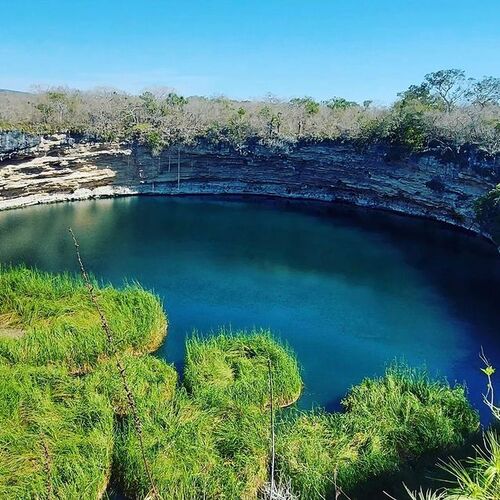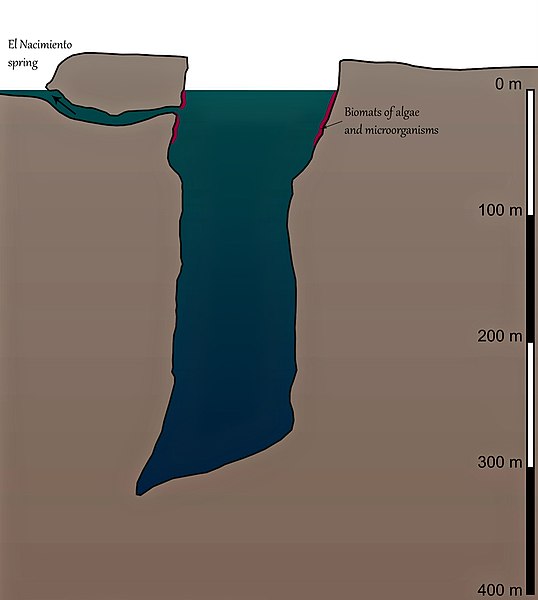Dive of Destiny: Tragic Loss of Finnin in El Zacaton Sinkhole


| Incident Location | Diver Full Name |
|---|---|
| Mexico, El Zacaton Sinkhole | Finnin |
Two brothers embarked on a daring deep dive adventure in the El Zacaton Sinkhole located in Mexico, aiming to beat their personal diving record. However, during the ascent, a malfunction with one brother’s BCD (Buoyancy Control Device) led to an uncontrolled rapid ascent, putting them at risk of nitrogen narcosis and other dangers.
The Remarkable El Zacaton Sinkhole
El Zacaton Sinkhole is a unique natural wonder located in northeastern Mexico, near the town of Aldama. Measuring approximately 328 feet across and plunging to depths of more than 339 meters, it is the deepest water-filled sinkhole on Earth. What makes El Zacaton exceptional is its formation by volcanic forces, not regular groundwater. It’s part of Systema Zacaton, a region featuring about 20 distinct geological features, including sinkholes, caves, and springs.

A Hub for Professional Divers
El Zacaton Sinkhole has garnered global attention from professional divers since the late 1980s, with some achieving world records in its depths. Finn and Lewis, aged 35, were two such enthusiasts, well-known in their community for their love of diving.
The Brothers’ Diving Background
Finn, a high school geography teacher who also ran a diving equipment store, and his brother Rex, a soldier, shared a passion for exploring the underwater world. They started diving in high school, drawn to the sea after a family tragedy. However, Finn’s high blood pressure diagnosis briefly forced him to stop diving, with Rex also putting his diving activities on hold in support.
Setting a New Diving Record
Once Finn’s health improved, the brothers were eager to resume their diving adventures. They decided to beat their personal deep dive record of 180 feet by diving to a challenging depth of 246 feet. Their motivation was to continually improve their diving skills and enjoy the experience.
Preparing for the Dive
Before embarking on the record-breaking dive, the brothers engaged in weeks of physical training. However, Finn had a period of rustiness due to his prior health issues. To address this, they focused on psychological and dietary improvements, listening to positive diving affirmations and ensuring Finn stayed hydrated despite his blood pressure condition.
The Dive Day
As the day of the dive approached, Rex was excited and ready for the challenge. Finn, on the other hand, experienced negative emotions on the morning of the dive but chose to proceed, believing it was just pre-dive jitters.
The brothers packed their diving gear, including diving computers, diving tanks, diving masks, and diving suits, and drove to the dive location, picking up two support divers on the way. At the dive site, they suited up an hour before the dive.
Warm-up and Final Checks
They began with a 50-minute warm-up, ensuring their bodies were prepared for the deep dive. Rex continually checked on Finn’s emotional state to ensure he was ready for the challenge. They performed exercises like pack stretches and facial immersion, all while maintaining communication and mental readiness.
The Descent
As the official countdown commenced, the brothers donned their diving masks and started their descent. The dive initially proceeded uneventfully as they surpassed their previous record of 180 feet. They were en route to their challenging goal of 246 feet.
A Sudden Turn of Events
However, at this point, something unexpected occurred that would change the course of their deep dive adventure. About 20 feet from their target depth, the BCD of one of the brothers started to inflate on its own, causing an uncontrolled and rapid ascent. This incident left them at risk of nitrogen narcosis and other potential dangers.
The events that followed would put their skills, preparation, and determination to the ultimate test.
as the two brothers were ascending from their deep dive, they were filled with excitement and satisfaction, believing they were about to achieve what they had intensely practiced for. They began their ascent, and everything seemed to be going smoothly.
A Sudden Emergency
However, at a depth of 75 feet, Rex noticed something alarming. Finnin’s BCD (Buoyancy Control Device) was inflating on its own. This was a situation Rex had encountered years ago when they had dived together. In the past, Finnin had quickly disconnected the air hose to rectify the issue. Rex expected Finnin to do the same this time.
However, Finnin’s response was different, and it posed a severe risk. Instead of disconnecting the air hose, Finnin was kicking frantically and trying to stay underwater. This erratic behavior didn’t last long, as Finnin suddenly stopped kicking and shot up to the surface. Rex followed his brother, concerned about ascending too quickly, especially since his dive computer was beeping warnings.
A Tragic Outcome
Upon reaching the surface, Rex made a horrifying discovery. Finnin had been pulled up, and rescuers were performing CPR on him. Rex learned that help had already been summoned, but a sense of panic washed over him. He wondered why Finnin hadn’t used his dump valve, a crucial safety feature that would have prevented the rapid ascent.
Rex noticed that the string to open the dump valve was missing, leaving Finnin without a means to release the excess air. During a deep dive ascent, it’s vital to ascend slowly to allow the body to expel dissolved gases safely. A fast ascent can lead to the formation of gas bubbles in the arteries and veins, potentially causing embolisms and decompression sickness.
Cause of Death
Regrettably, Finnin’s condition deteriorated rapidly, and he stopped breathing before he could be transported to the hospital. An autopsy revealed that he had panicked and died due to low blood pressure. His blood pressure reading was less than 90 over 60, a critical condition for any diver. If it had been solely the rapid ascent, it could have been treated in a decompression chamber.
The Importance of Equipment Safety
This tragic incident underscores the critical importance of checking and ensuring the reliability of all diving gear before any dive. Even a minor fault can have fatal consequences.
Conclusion
In memory of Finnin and as a cautionary tale for all divers, we emphasize the significance of safety measures and equipment checks to prevent diving tragedies. Diving should always be conducted with the utmost care and attention to safety protocols. We hope that this story serves as a reminder of the potential risks involved in this adventurous sport and encourages divers to prioritize their well-being and preparedness. Thank you for watching this video, and if you found it informative, please consider liking and subscribing for more exciting cave diving stories.
FAQ
El Zacaton Sinkhole is over 339 meters deep, making it the deepest water-filled sinkhole on Earth.
The water temperature in El Zacaton Sinkhole is typically around 77°F (25°C).
The incident was caused by a malfunction in one diver’s BCD (Buoyancy Control Device), leading to an uncontrolled rapid ascent and fatal consequences.
